Evaluating the Stability of PLA-Lignin Filament Produced by Bench-Top Extruder for Sustainable 3D Printing
Abstract
1. Introduction
2. Materials and Methods
2.1. Materials
2.2. Preparation of Composites
2.3. Filament Extrusion
2.4. Characterization
3. Results
3.1. Chemical and Thermochemical Characterizations
3.2. Stability of Filament Composites
3.3. Interlayer Adhesion of Infused Lignin
| Polymer/ Composite | Lignin (wt.%) | Filament Extrusion Technique | Printing Temp. (°C) | Tensile Strength (MPa) | Improvement | Ref. |
|---|---|---|---|---|---|---|
| PLA | 40 | Single-screw | 215 | 45.65 | 50% antioxidant potential/cm2 | [11] |
| PHB | 50 | Twin-screw | 190 | - | 34–78% less warpage | [36] |
| ABS/NBR/ carbon fiber | 40 | Single-screw | 230 | 65 | Improved interlayer adhesion | [13] |
| PLA | 3 | Single-screw | 185–205 | - | Antioxidant property | [19] |
| PLA/PEG | 20 | Twin-screw | 210 | 50.84 | Improved strength and elongation | [37] |
3.4. Forecasting the Mechanical Strength
4. Conclusions
Author Contributions
Funding
Conflicts of Interest
References
- Shahrubudin, N.; Lee, T.C.; Ramlan, R. An overview on 3D printing technology: Technological, materials, and applications. Procedia Manuf. 2019, 35, 1286–1296. [Google Scholar] [CrossRef]
- Mohan, D.; Teong, Z.K.; Bakir, A.N.; Sajab, M.S.; Kaco, H. Extending cellulose-based polymers application in additive manufacturing technology: A review of recent approaches. Polymers 2020, 12, 1876. [Google Scholar] [CrossRef]
- Dizon, J.R.C.; Espera, A.H.; Chen, Q.; Advincula, R.C. Mechanical characterization of 3D-printed polymers. Addit. Manuf. 2018, 20, 44–67. [Google Scholar] [CrossRef]
- Wohlers, T.T. 3D Printing and Additive Manufacturing State of the Industry; Wohlers Associates: Fort Collins, CO, USA, 2017. [Google Scholar]
- Yao, T.; Deng, Z.; Zhang, K.; Li, S. A method to predict the ultimate tensile strength of 3D printing polylactic acid (PLA) materials with different printing orientations. Compos. Part B Eng. 2019, 163, 393–402. [Google Scholar] [CrossRef]
- Derman, E.; Abdulla, R.; Marbawi, H.; Sabullah, M.K. Oil palm empty fruit bunches as a promising feedstock for bioethanol production in Malaysia. Renew. Energy 2018, 129, 285–298. [Google Scholar] [CrossRef]
- Mariana, M.; Alfatah, T.; Abdul Khalil, H.P.S.; Yahya, E.B.; Olaiya, N.G.; Nuryawan, A.; Mistar, E.M.; Abdullah, C.K.; Abdulmadjid, S.N.; Ismail, H. A Current Advancement on the Role of Lignin as Sustainable Reinforcement Material in Biopolymeric Blends. J. Mater. Res. Technol. 2021, 15, 2287–2316. [Google Scholar] [CrossRef]
- Lu, Y.; Lu, Y.C.; Hu, H.Q.; Xie, F.J.; Wei, X.Y.; Fan, X. Structural characterization of lignin and its degradation products with spectroscopic methods. J. Spectrosc. 2017, 2017, 8951658. [Google Scholar] [CrossRef]
- Hariz, H.B.; Zaidi, S.A.S.; Luthfi, A.A.I.; Bukhari, N.A.; Sajab, M.S.; Markom, M.; Harun, S.; Tan, J.P.; Ding, G.T.; Abdul, P.M. Succinic Acid Production from Oil Palm Biomass: A Prospective Plastic Pollution Solution. Fermentation 2023, 9, 46. [Google Scholar] [CrossRef]
- Mokhena, T.C.; Sefadi, J.S.; Sadiku, E.R.; John, M.J.; Mochane, M.J.; Mtibe, A. Thermoplastic Processing of PLA/Cellulose Nanomaterials Composites. Polymers 2018, 10, 1363. [Google Scholar] [CrossRef]
- Tanase-Opedal, M.; Espinosa, E.; Rodríguez, A.; Chinga-Carrasco, G. Lignin: A biopolymer from forestry biomass for biocomposites and 3D printing. Materials 2019, 12, 3006. [Google Scholar] [CrossRef]
- Xu, W.; Wang, X.; Sandler, N.; Willför, S.; Xu, C. Three-dimensional printing of wood-derived biopolymers: A review focused on biomedical applications. ACS Sustain. Chem. Eng. 2018, 6, 5663–5680. [Google Scholar] [CrossRef]
- Nguyen, N.A.; Bowland, C.C.; Naskar, A.K. A general method to improve 3D-printability and inter-layer adhesion in lignin-based composites. Appl. Mater. Today 2018, 12, 138–152. [Google Scholar] [CrossRef]
- Pairon, M.S.; Ali, F.; Anuar, H.; Ahmad, F.; Suhr, J.; Mirghani, M.E.S. Reinforcement of Polylactic Acid (PLA) Bio-Composite with Lignin from Oil Palm Empty Fruit Bunches (OPEFB) for 3D Printing Application. In Proceedings of the IOP Conference Series: Materials Science and Engineering, Kuala Lumpur, Malaysia, 22–23 June 2021; p. 012014. [Google Scholar]
- Mimini, V.; Sykacek, E.; Hashim, S.N.A.; Holzweber, J.; Hettegger, H.; Fackler, K. Compatibility of kraft lignin, organosolv lignin and lignosulfonate with PLA in 3D printing. J. Wood Chem. Technol. 2019, 39, 14–30. [Google Scholar] [CrossRef]
- Gkartzou, E.; Koumoulos, E.P.; Charitidis, C.A. Production and 3D printing processing of bio-based thermoplastic filament. Manuf. Rev. 2017, 4, 14. [Google Scholar] [CrossRef]
- Ye, H.; Zhang, Y.; Yu, Z. Effect of desulfonation of lignosulfonate on the properties of poly(lactic acid)/lignin composites. BioResources 2017, 12, 4810–4829. [Google Scholar] [CrossRef]
- Domínguez-Robles, J.; Martin, N.K.; Fong, M.L.; Stewart, S.A.; Irwin, N.J.; Rial-Hermida, M.I.; Larrañeta, E. Antioxidant PLA composites containing lignin for 3D printing applications: A potential material for healthcare applications. Pharmaceutics 2019, 11, 165. [Google Scholar] [CrossRef]
- Hong, S.H.; Park, J.H.; Kim, O.Y.; Hwang, S.H. Preparation of chemically modified lignin-reinforced PLA bio-composites and their 3D printing performance. Polymers 2021, 13, 667. [Google Scholar] [CrossRef]
- Obielodan, J.; Vergenz, K.; Aqil, D.; Wu, J.; Ellistrem, L.M. Characterization of PLA/lignin biocomposites for 3D printing. In Proceedings of the 30th Annual International Solid Freeform Fabrication Symposium—An Additive Manufacturing Conference, Austin, TX, USA, 12–14 August 2019; pp. 998–1007. [Google Scholar]
- Wu, Y.; Wang, K.; Neto, V.; Peng, Y.; Valente, R.; Ahzi, S. Correction to: Interfacial Behaviors of Continuous Carbon Fiber Reinforced Polymers Manufactured by Fused Filament Fabrication: A Review and Prospect. Int. J. Mater. Form. 2023, 16, 17. [Google Scholar] [CrossRef]
- Patanwala, H.S.; Hong, D.; Vora, S.R.; Bognet, B.; Ma, A.W.K. The microstructure and mechanical properties of 3D printed carbon nanotube-polylactic acid composites. Polym. Compos. 2018, 39, E1060–E1071. [Google Scholar] [CrossRef]
- Wang, J.; Tan, Q.; Wang, K.; Yao, S.; Peng, Y.; Rao, Y. A heat-press-treatment method for 3D printed thin-walled composite structures with improved interfacial and compressive properties. Polym. Compos. 2022, 43, 8471. [Google Scholar] [CrossRef]
- Mohan, D.; Bakir, A.N.; Sajab, M.S.; Bakarudin, S.B.; Mansor, N.N.; Roslan, R.; Kaco, H. Homogeneous distribution of lignin/graphene fillers with enhanced interlayer adhesion for 3D printing filament. Polym. Compos. 2021, 42, 2408–2421. [Google Scholar] [CrossRef]
- Ibrahim, F.; Mohan, D.; Sajab, M.S.; Bakarudin, S.B.; Kaco, H. Evaluation of the Compatibility of Organosolv Lignin-Graphene Nanoplatelets with Photo-Curable Polyurethane in Stereolithography 3D Printing. Polymers 2019, 11, 1544. [Google Scholar] [CrossRef]
- Restrepo, I.; Medina, C.; Meruane, V.; Akbari-Fakhrabadi, A.; Flores, P.; Rodríguez-Llamazares, S. The Effect of Molecular Weight and Hydrolysis Degree of Poly(Vinyl Alcohol)(PVA) on the Thermal and Mechanical Properties of Poly(Lactic Acid)/PVA Blends. Polimeros 2018, 28, 169–177. [Google Scholar] [CrossRef]
- Ainali, N.M.; Tarani, E.; Zamboulis, A.; Črešnar, K.P.; Zemljič, L.F.; Chrissafis, K.; Lambropoulou, D.A.; Bikiaris, D.N. Thermal Stability and Decomposition Mechanism of PLA Nanocomposites with Kraft Lignin and Tannin. Polymers 2021, 13, 2818. [Google Scholar] [CrossRef]
- Masood, S.H. Advances in Fused Deposition Modeling. Compr. Mater. Process. 2014, 10, 69–91. [Google Scholar] [CrossRef]
- Dehne, L.; Vila, C.; Saake, B.; Schwarz, K.U. Esterification of Kraft lignin as a method to improve structural and mechanical properties of lignin-polyethylene blends. J. Appl. Polym. Sci. 2016, 134, 44582. [Google Scholar] [CrossRef]
- Li, J.; Bai, X.; Dong, Z.; Chen, Y.; Yang, H.; Wang, X.; Chen, H. Influence of additives on lignin agglomeration and pyrolysis behavior. Fuel 2020, 263, 116629. [Google Scholar] [CrossRef]
- Spiridon, I.; Leluk, K.; Resmerita, A.M.; Darie, R.N. Evaluation of PLA-lignin bioplastics properties before and after accelerated weathering. Compos. Part B Eng. 2015, 69, 342–349. [Google Scholar] [CrossRef]
- Vásquez-Garay, F.; Carrillo-Varela, I.; Vidal, C.; Reyes-Contreras, P.; Faccini, M.; Teixeira Mendonça, R. A Review on the Lignin Biopolymer and Its Integration in the Elaboration of Sustainable Materials. Sustainability 2021, 13, 2697. [Google Scholar] [CrossRef]
- Nanni, A.; Cancelli, U.; Montevecchi, G.; Masino, F.; Messori, M.; Antonelli, A. Functionalization and Use of Grape Stalks as Poly(Butylene Succinate) (PBS) Reinforcing Fillers. Waste Manag. 2021, 126, 538–548. [Google Scholar] [CrossRef]
- Rojas-Lema, S.; Arevalo, J.; Gomez-Caturla, J.; Garcia-Garcia, D.; Torres-Giner, S. Peroxide-Induced Synthesis of Maleic Anhydride-Grafted Poly(butylene succinate) and Its Compatibilizing Effect on Poly(butylene succinate)/Pistachio Shell Flour Composites. Molecules 2021, 26, 5927. [Google Scholar] [CrossRef] [PubMed]
- Zhou, X.; Ren, Z.; Sun, H.; Bi, H.; Gu, T.; Xu, M. 3D printing with high content of lignin enabled by introducing polyurethane. Int. J. Biol. Macromol. 2022, 221, 1209–1217. [Google Scholar] [CrossRef]
- Vaidya, A.A.; Collet, C.; Gaugler, M.; Lloyd-Jones, G. Integrating softwood biorefinery lignin into polyhydroxybutyrate composites and application in 3D printing. Mater. Today Commun. 2019, 19, 286–296. [Google Scholar] [CrossRef]
- Wasti, S.; Triggs, E.; Farag, R.; Auad, M.; Adhikari, S.; Bajwa, D.; Ragauskas, A.J. Influence of plasticizers on thermal and mechanical properties of biocomposite filaments made from lignin and polylactic acid for 3D printing. Compos. Part B Eng. 2021, 205, 108483. [Google Scholar] [CrossRef]
- Rajpurohit, S.R.; Dave, H.K. Prediction and Optimization of Tensile Strength in FDM Based 3D Printing Using ANFIS. In Springer Series in Advanced Manufacturing; Springer Nature: Cham, Switzerland, 2020; pp. 111–128. [Google Scholar] [CrossRef]
- Shehabeldeen, T.A.; Zhou, J.; Shen, X.; Yin, Y.; Ji, X. Comparison of RSM with ANFIS in predicting tensile strength of dissimilar friction stir welded AA2024 -AA5083 aluminium alloys. Procedia Manuf. 2019, 37, 555–562. [Google Scholar] [CrossRef]
- Seputra, Y.E.A.; Soegijono, B. Optimation of AMC’s Tensile Properties Using Adaptive Neuro-Fuzzy Inference System (ANFIS). In Proceedings of the IOP Conference Series: Materials Science and Engineering, Malang, Indonesia, 5 September 2018; p. 012099. [Google Scholar]
- Abhulimen, I.U.; Achebo, J.I. The Use of Adaptive Neuro Fuzzy Inference System (ANFIS) in Modeling the Weld Output of a Tig Welded Pipe Joint. Int. J. Res. Eng. Technol. 2014, 2, 99–110. [Google Scholar]


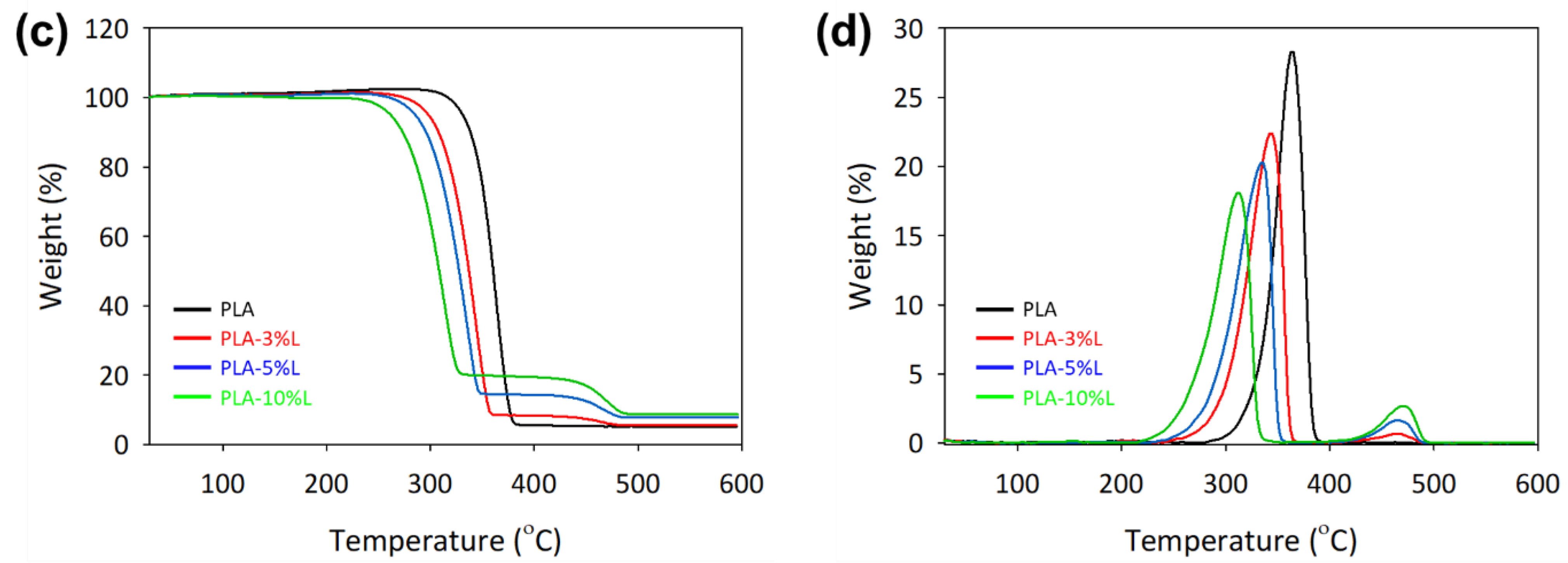
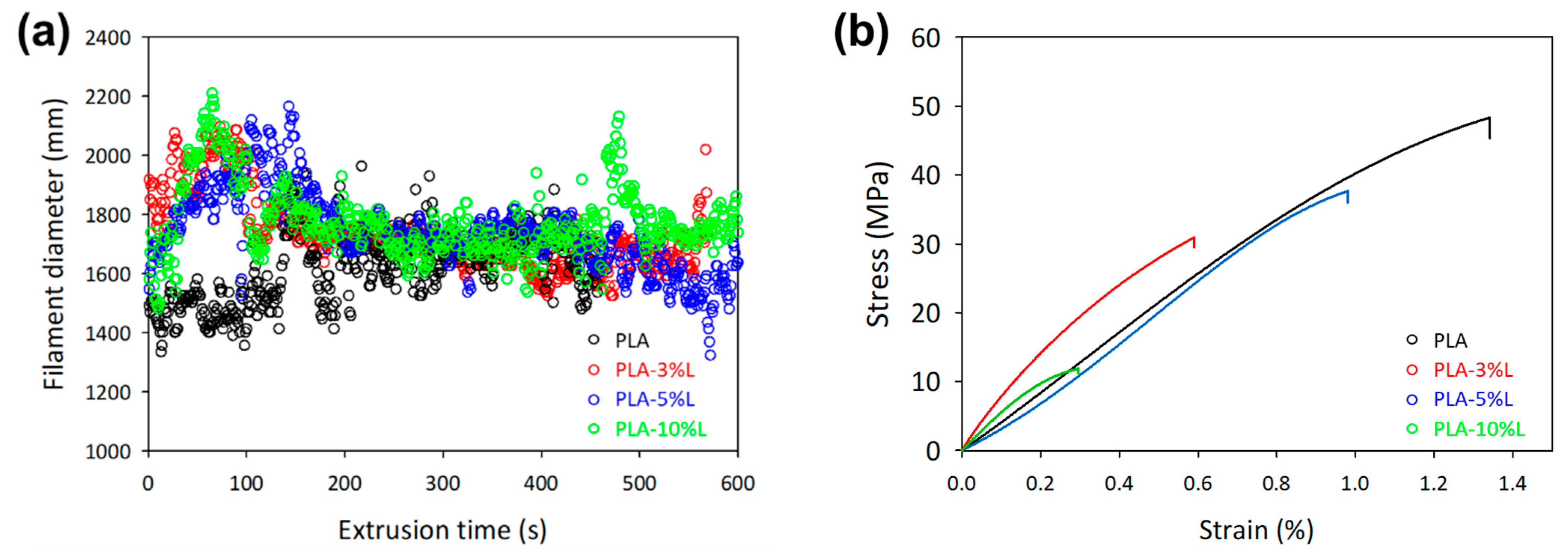
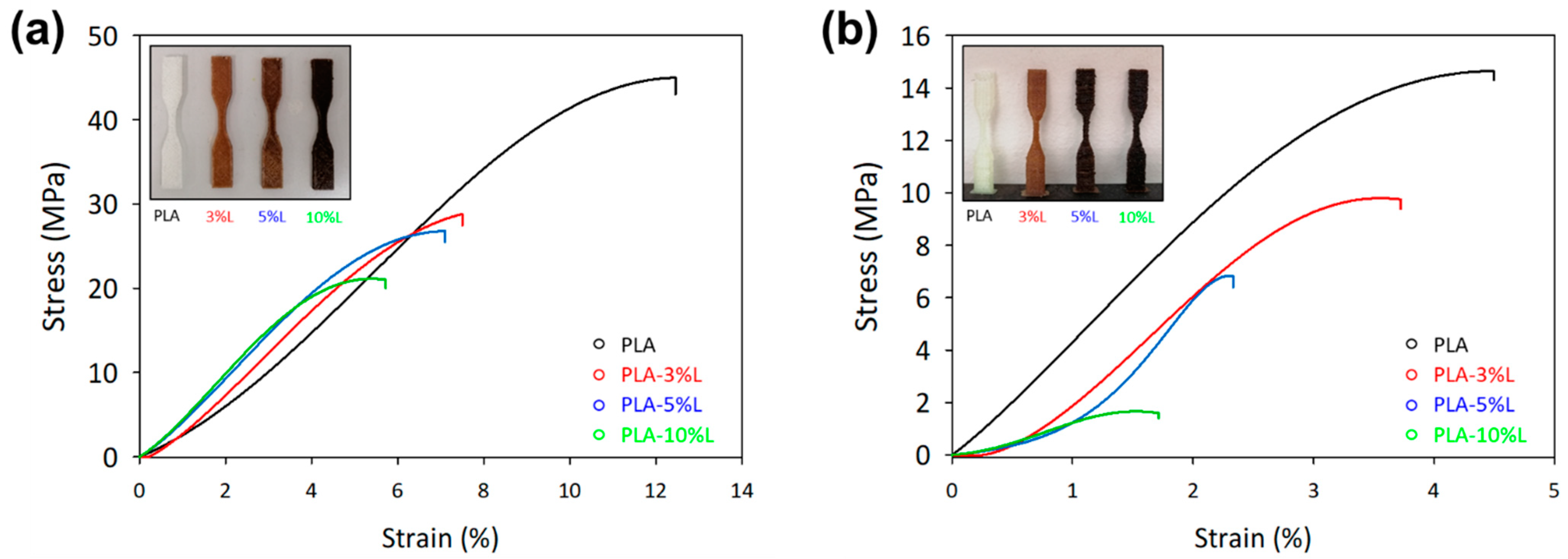

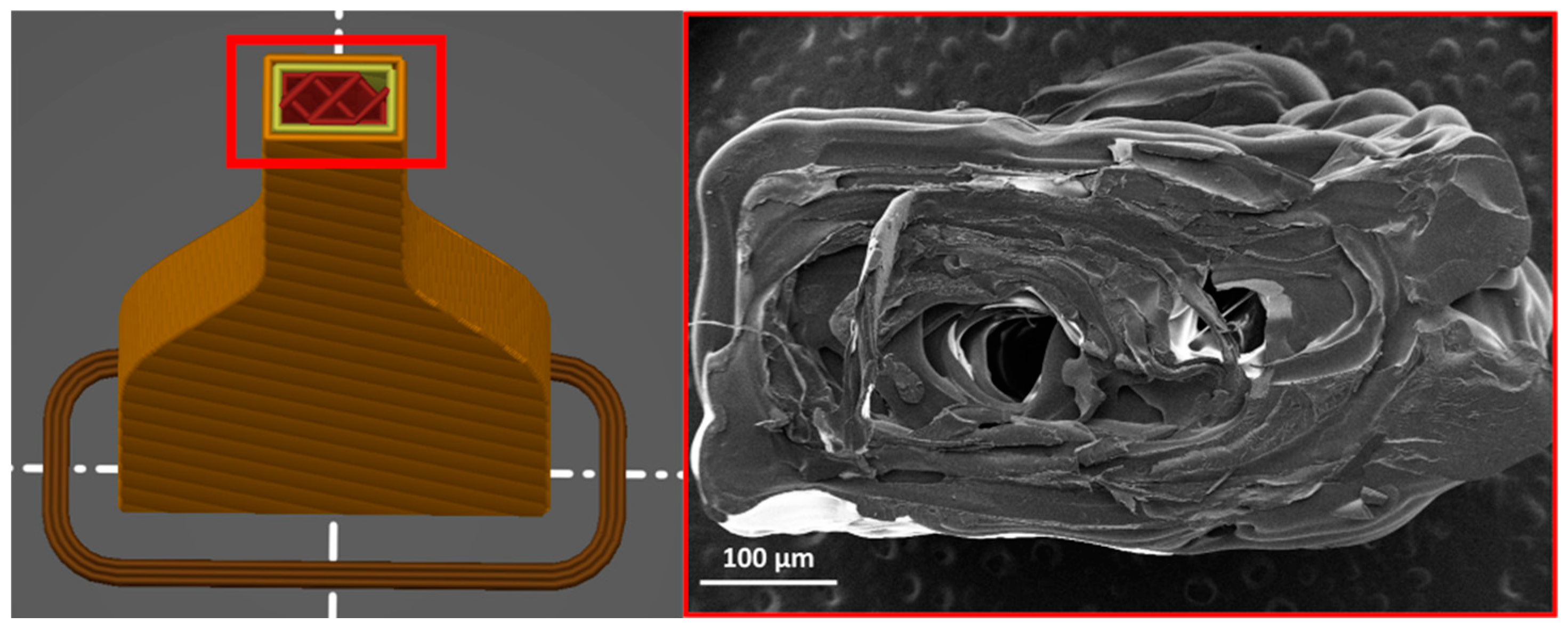
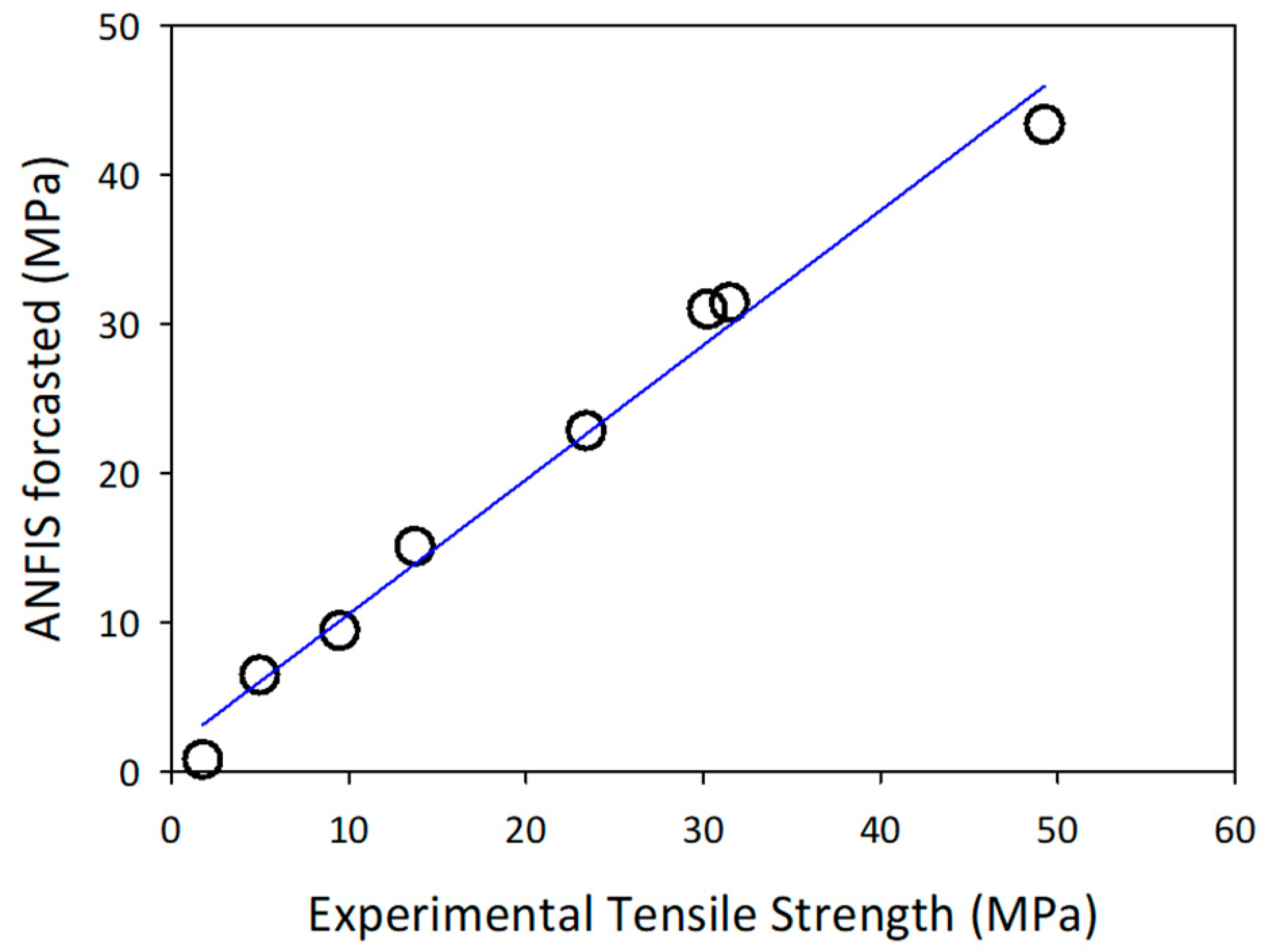
| Sample | Tg (°C) | Residue at 600 °C (%) | DTGmax (°C) |
|---|---|---|---|
| PLA | 155.3 | 5.17 | 364.89 |
| PLA-3%L | 155.5 | 5.54 | 344.64 |
| PLA-5%L | 155.2 | 7.84 | 335.87 |
| PLA-10%L | 154.5 | 18.54 | 295.81 |
| Sample | Tensile Strength (MPa) | Tensile Strain (%) | Young’s Modulus (MPa) |
|---|---|---|---|
| Filament PLA | 49.57 ± 0.89 | 38.66 ± 0.50 | 377 ± 0.03 |
| Filament PLA-3%L | 31.01 ± 0.93 | 18.39 ± 0.64 | 417 ± 0.02 |
| Filament PLA-5%L | 37.33 ± 0.75 | 24.41 ± 0.83 | 419 ± 0.04 |
| Filament PLA-10%L | 12.8 ± 0.57 | 12.54 ± 0.22 | 288 ± 0.05 |
| PLA (0°) | 49.25 ± 0.21 | 12.85 ± 0.16 | 488 ± 0.03 |
| PLA-3%L (0°) | 31.48 ± 0.30 | 7.70 ± 0.20 | 654 ± 0.02 |
| PLA-5%L (0°) | 30.23 ± 0.12 | 7.37 ± 0.13 | 548 ± 0.04 |
| PLA-10%L (0°) | 23.38 ± 0.09 | 5.8 ± 0.24 | 524 ± 0.05 |
| PLA (90°) | 13.72 ± 0.10 | 4.47 ± 0.05 | 479 ± 0.04 |
| PLA-3%L (90°) | 9.48 ± 0.15 | 3.85 ± 0.03 | 489 ± 0.02 |
| PLA-5%L (90°) | 4.96 ± 0.08 | 2.84 ± 0.04 | 578 ± 0.03 |
| PLA-10%L (90°) | 1.75 ± 0.12 | 1.89 ± 0.07 | 209 ± 0.05 |
| Sample | Tensile Strength (MPa) | ANFIS Forecast (MPa) |
|---|---|---|
| PLA (0°) | 49.25 ± 0.21 | 43.40 |
| PLA-3%L (0°) | 31.48 ± 0.30 | 31.48 |
| PLA-5%L (0°) | 30.23 ± 0.12 | 31.04 |
| PLA-10%L (0°) | 23.38 ± 0.09 | 22.89 |
| PLA (90°) | 13.72 ± 0.10 | 15.11 |
| PLA-3%L (90°) | 9.48 ± 0.15 | 9.48 |
| PLA-5%L (90°) | 4.96 ± 0.08 | 6.50 |
| PLA-10%L (90°) | 1.75 ± 0.12 | 0.82 |
Disclaimer/Publisher’s Note: The statements, opinions and data contained in all publications are solely those of the individual author(s) and contributor(s) and not of MDPI and/or the editor(s). MDPI and/or the editor(s) disclaim responsibility for any injury to people or property resulting from any ideas, methods, instructions or products referred to in the content. |
© 2023 by the authors. Licensee MDPI, Basel, Switzerland. This article is an open access article distributed under the terms and conditions of the Creative Commons Attribution (CC BY) license (https://creativecommons.org/licenses/by/4.0/).
Share and Cite
Zaidi, S.A.S.; Kwan, C.E.; Mohan, D.; Harun, S.; Luthfi, A.A.I.; Sajab, M.S. Evaluating the Stability of PLA-Lignin Filament Produced by Bench-Top Extruder for Sustainable 3D Printing. Materials 2023, 16, 1793. https://doi.org/10.3390/ma16051793
Zaidi SAS, Kwan CE, Mohan D, Harun S, Luthfi AAI, Sajab MS. Evaluating the Stability of PLA-Lignin Filament Produced by Bench-Top Extruder for Sustainable 3D Printing. Materials. 2023; 16(5):1793. https://doi.org/10.3390/ma16051793
Chicago/Turabian StyleZaidi, Siti Aisyah Syazwani, Cham Eng Kwan, Denesh Mohan, Shuhaida Harun, Abdullah Amru Indera Luthfi, and Mohd Shaiful Sajab. 2023. "Evaluating the Stability of PLA-Lignin Filament Produced by Bench-Top Extruder for Sustainable 3D Printing" Materials 16, no. 5: 1793. https://doi.org/10.3390/ma16051793
APA StyleZaidi, S. A. S., Kwan, C. E., Mohan, D., Harun, S., Luthfi, A. A. I., & Sajab, M. S. (2023). Evaluating the Stability of PLA-Lignin Filament Produced by Bench-Top Extruder for Sustainable 3D Printing. Materials, 16(5), 1793. https://doi.org/10.3390/ma16051793











